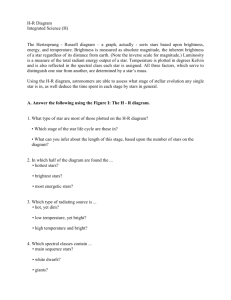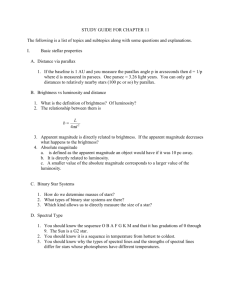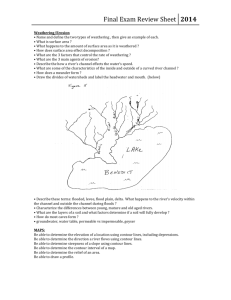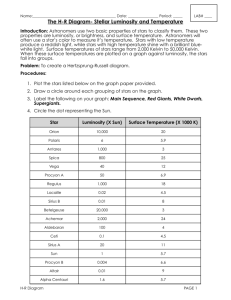Understanding Stars
advertisement
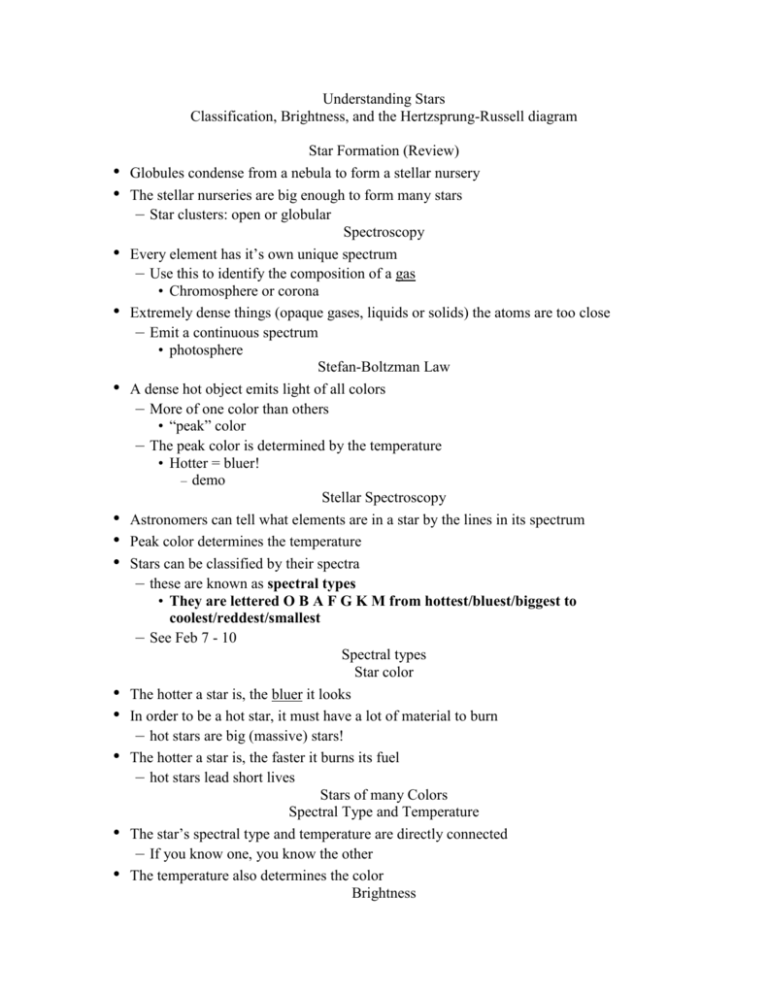
Understanding Stars Classification, Brightness, and the Hertzsprung-Russell diagram • • • • • • • • • • • • • Star Formation (Review) Globules condense from a nebula to form a stellar nursery The stellar nurseries are big enough to form many stars – Star clusters: open or globular Spectroscopy Every element has it’s own unique spectrum – Use this to identify the composition of a gas • Chromosphere or corona Extremely dense things (opaque gases, liquids or solids) the atoms are too close – Emit a continuous spectrum • photosphere Stefan-Boltzman Law A dense hot object emits light of all colors – More of one color than others • “peak” color – The peak color is determined by the temperature • Hotter = bluer! – demo Stellar Spectroscopy Astronomers can tell what elements are in a star by the lines in its spectrum Peak color determines the temperature Stars can be classified by their spectra – these are known as spectral types • They are lettered O B A F G K M from hottest/bluest/biggest to coolest/reddest/smallest – See Feb 7 - 10 Spectral types Star color The hotter a star is, the bluer it looks In order to be a hot star, it must have a lot of material to burn – hot stars are big (massive) stars! The hotter a star is, the faster it burns its fuel – hot stars lead short lives Stars of many Colors Spectral Type and Temperature The star’s spectral type and temperature are directly connected – If you know one, you know the other The temperature also determines the color Brightness • • How bright a star looks depends on how far away it is, and how bright it really is. – Car example More Brightness The same is true of stars – The same kinds of stars are equally bright, • Brighter means closer for stars of the same type – different kinds of stars can be different brightnesses regardless of their distances • The actual brightness depends on the star’s diameter Absolute Magnitude • Astronomers refer to the brightness of a star as the magnitude – apparent magnitude – how bright it looks from here • see Jan 9 or the week 2 lecture – Absolute magnitude – how bright the star would be at 10 parsecs. • Measure of how bright it really is – Reminder: small magnitudes are bright • A parsec is 3.26 light years Luminosity • Luminosity: how much energy the star puts out. – luminosity is a measure of the energy in the form of photons • Big luminosities are bright – 1 order of magnitude is roughly equal to 20 units of luminosity Absolute Magnitude and Luminosity • 2 different ways of measuring the same thing – like Celsius and Fahrenheit The H-R diagram • Hertzsprung and Russell graphed absolute magnitude vs. spectral type – Their graph became known as a Hertzsprung-Russell diagram, or H-R diagram – It is one of the most important tools in astronomy • different types of stars find homes in different parts of the graph (please look at p 44 now) More H-R diagram • Temperature, color, and spectral type are all related, and are generally graphed on the horizontal axis – Mass increases with temperature ON THE MAIN SEQUENCE ONLY • Luminosity and Absolute Magnitude are related, and are generally graphed on the vertical axis. – Remember: greater Luminosities correspond to smaller magnitudes! The Main sequence • Stars spend most of the lives on the main sequence (see p 44 again) • Main sequence stars are very common – There are many stars that are not main sequence stars. • Very young and dying stars.


